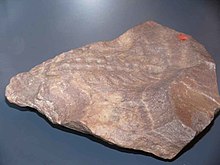| Xenusion auerswaldae Temporal range:
| |
|---|---|

| |
| Fossil specimen | |

| |
| Life restoration | |
| Scientific classification | |
| Domain: | Eukaryota |
| Kingdom: | Animalia |
| (unranked): | Panarthropoda |
| Phylum: | †"Lobopodia" |
| Class: | †Xenusia |
| Order: | †Protonychophora |
| Family: | †Xenusiidae |
| Genus: | †Xenusion Pompeckj, 1927 |
| Species: | †X. auerswaldae
|
| Binomial name | |
| †Xenusion auerswaldae Pompeckj, 1927
| |
Xenusion auerswaldae is an early lobopodian known from three[1] specimens found in glacial erratics on the Baltic coast of Germany.[2] Another specimen, discovered shortly after the holotype, was briefly observed but soon went missing. Except for this lost specimen, the fossils probably originated in the Kalmarsund Sandstone of Southern Sweden,[3] which was deposited in the Lower Cambrian (Upper Tommotian–Lower Atdabanian; Stages 2→3).[4] It is the oldest currently known lobopodian with soft body fossils.[5]
The specimens are not especially well preserved. The older specimen is 10 cm or so in length with a narrow, weakly segmented body. Assuming it was the posterior section, the specimen was estimated to be part of an animal about 20 cm in length.[2] A depression runs up the bottom on all but the rearmost segments. There is a slightly bulbous termination, and each segment before that seems to have a single pair of tapering annulated legs similar to the modern onychophoran, but without specialized feet and claws. More than 10 body segments were present.[6] There is presumably a spine on each body bump and faint transverse parallel striations on the annulations on the legs.[2][6] The legs of what is possibly the foremost segments are either absent or not preserved. The head is believed to be missing or poorly preserved. Based on a new specimen that shows the anterior section, it possibly had a long narrow proboscis,[2] but this also suggested to be a preservational artefact.[7]
Xenusion has been reinterpreted as an Ediacaran frond animal by Tarlo, and a drawing of that interpretation has been presented by McMenamin.[8] In a photograph presented in The Treatise on Invertebrate Paleontology Volume O, the organism's appearance seems to support the original interpretation more. Further studies of Xenusiid close the possibility of a Rangeomorphy affinity.[2][6]
- ^ "Oudste fossiel van Nederland naar Hunebedcentrum: 600 miljoen jaar oud". www.rtvdrenthe.nl (in Dutch). 22 November 2022. Retrieved 7 November 2024.
- ^ a b c d e Dzik, J.; Krumbiegel, G. N. (1989). "The oldest 'onychophoran' Xenusion: A link connecting phyla?". Lethaia. 22 (2): 169. doi:10.1111/j.1502-3931.1989.tb01679.x.
- ^ Jaeger, Hermann; Martinsson, Anders (1967-01-31). "Remarks on the Problematic Fossil Xenusion Auerswaldae". Geologiska Föreningen i Stockholm Förhandlingar. 88 (4): 435–452. doi:10.1080/11035896709455501. ISSN 0016-786X.
- ^ Han, J.; Zhang, Z. -F.; Liu, J. -N. (2008). "A preliminary note on the dispersal of the Cambrian Burgess Shale-type faunas". Gondwana Research. 14 (1–2): 269–276. doi:10.1016/j.gr.2007.09.001.
- ^ Ou, Qiang; Mayer, Georg (2018-09-20). "A Cambrian unarmoured lobopodian, †Lenisambulatrix humboldti gen. et sp. nov., compared with new material of †Diania cactiformis". Scientific Reports. 8 (1): 13667. Bibcode:2018NatSR...813667O. doi:10.1038/s41598-018-31499-y. ISSN 2045-2322. PMC 6147921. PMID 30237414.
- ^ a b c Liu, Jianni; Dunlop, Jason A. (2014-03-15). "Cambrian lobopodians: A review of recent progress in our understanding of their morphology and evolution". Palaeogeography, Palaeoclimatology, Palaeoecology. Cambrian Bioradiation. 398: 4–15. Bibcode:2014PPP...398....4L. doi:10.1016/j.palaeo.2013.06.008. ISSN 0031-0182.
- ^ RAMSKÖLD, L. and CHEN, J.-Y. 1998. Cambrian lobopodians: morphology and phylogeny. In EDGECOMBE, G. D. (ed.) Arthropod Fossils and Phylogeny, Columbia University Press, New York, 107–150 pp.
- ^ McMenamin, Mark A. S. (1986). "The Garden of Ediacara". PALAIOS. 1 (2): 178–182. doi:10.2307/3514512. ISSN 0883-1351. JSTOR 3514512.